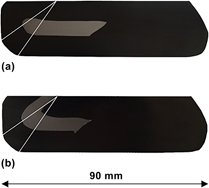Crossref Citations
This article has been cited by the following publications. This list is generated based on data provided by
Crossref.
Zhao, Hong
Ren, Yuping
Yang, Bo
and
Qin, Gaowu
2019.
Microstructural evolution of equal channel angular drawn purity titanium at room temperature.
Journal of Alloys and Compounds,
Vol. 811,
Issue. ,
p.
152002.
Heydarinia, Ali
Mohri, Maryam
Asghari-Rad, Peyman
Kim, Hyoung Seop
and
Nili-ahmadabadi, Mahmoud
2022.
Free volume formation and the high strength of pure Mg after room temperature core-sheath ECAP passes.
Journal of Materials Research and Technology,
Vol. 18,
Issue. ,
p.
147.
Daghigh, Milad
Mohri, Maryam
Ghanbari, Hossein
and
Nili-ahmadabadi, Mahmoud
2023.
The effect of thermal and strain-induced aging on the mechanical behavior of room temperature ECAP processing of WE43 magnesium alloy.
Journal of Materials Research and Technology,
Vol. 24,
Issue. ,
p.
8508.
Khebreh Farshchi, Yasamin
Khodabakhshi, Farzad
Mohri, Maryam
Shirazi, Hassan
and
Nili-Ahmadabadi, Mahmoud
2024.
Microstructural engineering in carbon steel walls printed by directed energy deposition to enhance mechanical properties through heat-input control.
Journal of Materials Research and Technology,
Vol. 28,
Issue. ,
p.
490.
Karelin, R.
Komarov, V.
Khmelevskaya, I.
Cherkasov, V.
Andreev, V.
Yusupov, V.
and
Prokoshkin, S.
2024.
Effect of temperature-deformation regimes of equal channel angular pressing in core-shell mode on the structure and properties of near-equiatomic titanium nickelide shape memory alloy.
Journal of Alloys and Compounds,
Vol. 1005,
Issue. ,
p.
176071.
Fakheri, Fatemeh
Pour-Ali, Sadegh
Tavangar, Reza
and
Naseri, Reza
2024.
Effect of ultrasonic assisted-ECAP processing on the microstructure, mechanical properties, and fluoride-induced corrosion performance of pure titanium.
Materials Today Communications,
Vol. 40,
Issue. ,
p.
109863.
Bajda, Szymon
Cholewa-Kowalska, Katarzyna
Krzyzanowski, Michal
Dziadek, Michal
Kopyscianski, Mateusz
Liu, Yijun
and
Rai, Adarsh
2024.
Laser-directed energy deposition of bioactive glass on Ti-6Al-7Nb titanium alloy substrate with highly refined grain structure.
Surface and Coatings Technology,
Vol. 485,
Issue. ,
p.
130904.
Daghigh, Milad
Mohri, Maryam
and
Nili-ahmadabadi, Mahmoud
2024.
Tailoring Deformation Homogeneity of WE43 Alloy through Strain Rate Sensitivity and Back Pressure during Equal Channel Angular Pressing.
Journal of Materials Engineering and Performance,
Vol. 33,
Issue. 22,
p.
12604.
Karelin, R.
Komarov, V.
Khmelevskaya, I.
Cherkasov, V.
Andreev, V.
Yusupov, V.
and
Prokoshkin, S.
2025.
Effect of equal channel angular pressing in core-shell mode on the structure and properties of nickel-enriched titanium nickelide shape memory alloy.
Journal of Alloys and Compounds,
Vol. 1044,
Issue. ,
p.
184590.


